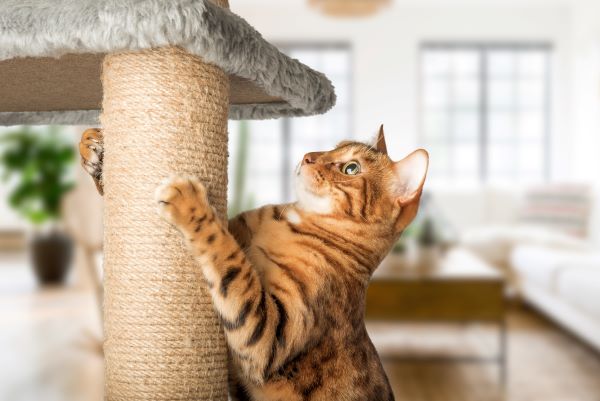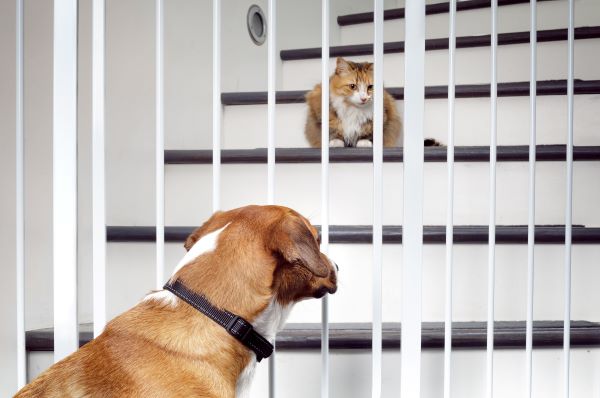
Bringing a new cat into your home is an exciting time, filled with love and anticipation. However, a careful and gentle approach is essential to ensure a smooth transition. From understanding how to introduce a new cat to other pets to creating a welcoming environment for your new feline family member, a few preparatory steps can make all the difference.
This blog will walk you through the best practices on:
- Preparing your home for your new cat
- How to introduce a cat to a new home
- How to introduce a cat to another cat
- How to introduce a cat to a dog
- Common mistakes to avoid when introducing cats
- FAQs about introducing cats to your home
Preparing Your Home for a Cat
The first step in welcoming any pet into your home is preparation. Before bringing a new cat home, ensure you have all the essentials, including a litter box, food, water bowls, and a cozy bed. Having these items ready will make your cat feel more safe and comfortable in its new environment.
Before your new cat arrives:
- Create a Safe Space: Set up a quiet room with essentials like food, water, a litter box, and a comfortable bed. This space will serve as the cat’s sanctuary during the initial days. Be sure to create distance from the cat’s water and food sources.
- Cat-proof your home by removing hazardous items and securing loose cords. Ensure windows and doors are secure to prevent accidental escapes.
- Provide Enrichment: Toys, scratching posts, and climbing structures can help your cat adjust by keeping them engaged. Cats love elevated play spaces, so adding a perch or other form of elevated resting spot would be a welcome addition for your new pet.

How to Introduce a Cat to a New Home
When introducing a cat to a new home, giving them time to adjust at their own pace is essential. Cats are territorial, and a sudden change of environment can be overwhelming.
When bringing a cat into a new environment, patience is crucial.
- Allow Time for Adjustment: Let your cat explore their safe space for hours or days before introducing them to the rest of the house.
- Gradual Exploration: Slowly open up more areas of your home for your cat to explore under your supervision.
- Establish a Routine: Feeding, play, and sleep routines can help cats feel more secure, making them more willing to explore.
Introducing a New Cat to Other Pets
No matter the situation—whether you’re introducing a cat to another cat, a dog, or simply to a new home—building trust through positive reinforcement is essential. Use treats, toys, and calm, encouraging words to help your new cat feel safe.
Avoiding Punishment or Negative Reactions
Cats are sensitive to stress and negative reinforcement. Never punish a cat for hissing or hiding; these behaviors are natural reactions to fear or uncertainty. Instead, reward calm behavior, creating positive associations with new experiences. Provide plenty of positive reinforcement, treats, and praise to all pets during these encounters.
Giving Each Animal Time and Space
If you have multiple pets, remember that each animal adjusts at their own pace. Allow each pet to take their time, offering reassurance and positive attention to both the new and existing pets to avoid jealousy or rivalry.
How to Introduce Cats to Each Other

Adding a second cat to your household requires patience and understanding of feline behavior. Cats are territorial, so a gradual introduction is essential for a peaceful coexistence.
- Separate at First: Keep the new cat in a separate room for the first few days. This allows each cat to become familiar with the other’s scent without direct interaction.
- Scent-Swapping: Swap bedding between the two cats to help them get used to each other’s scent. You can also rub a towel on one cat and place it in the other’s space.
- Controlled Visual Introduction: After a few days, let the cats see each other through a cracked door or baby gate. Observe their behavior and watch for any signs of aggression.
- Short, Supervised Interactions: Once the cats are comfortable, allow short, supervised face-to-face meetings. Keep these sessions brief, gradually extending them as they show more tolerance for each other.
- Provide Individual Resources: Ensure each cat has a separate food bowl, litter box, and resting area to reduce competition and territorial disputes.
How to Introduce a Cat to a Dog

Introducing a cat to a dog can be a bit trickier, as dogs and cats communicate differently. However, with patience and gradual exposure, cats and dogs can learn to coexist – and sometimes even form close bonds.
- Start with Scent Introduction: Let the cat and dog smell each other’s bedding or toys to introduce them to each other’s scent.
- Separate Spaces: Initially, keep them in separate areas to allow them to adjust to each other’s presence without direct contact. Gates or crates can help with separation and allow safe observation.
- Training Commands: Ensure your dog understands basic commands like “sit” and “stay” to maintain control during interactions.
- Controlled First Meeting: Keep the dog on a leash and allow the cat to observe from a safe distance. This helps the cat feel in control of the interaction.
- Reward Calm Behavior: Reward the dog for staying calm and avoid any behavior that could alarm the cat, such as barking or lunging.
- Short, Gradual Interactions: Gradually increase the duration of their meetings, always ensuring the cat has an escape route if needed.
- Monitor Ongoing Interactions: Be cautious with unsupervised interactions until you know both animals feel comfortable and safe.
Tips for a Successful Introduction
- Patience is Key: Rushing the process can lead to setbacks. Allow your pets to progress at their own pace.
- Consistency: Maintain routines to reduce stress for all pets involved.
- Professional Guidance: If you’re experiencing difficulties, consider consulting a veterinarian or a professional animal behaviorist.
Common Mistakes to Avoid When Introducing Cats
Successfully introducing cats to each other, a dog, or to a new home requires patience and planning. Avoiding common mistakes can make the transition smoother.
Mistakes to Avoid:
- Rushing the Introduction: Cats need time to adjust. Rushing introductions can lead to stress and possible aggression.
- Neglecting Existing Pets: Be mindful to give your existing pets attention and affection to prevent jealousy or behavioral issues.
- Ignoring Warning Signs: Hissing, growling, or swatting should not be ignored. These are signs that your pets may need more time before progressing with introductions.
- Not Providing Escape Routes: Cats need to feel they can escape if threatened. Always ensure they have a safe space to retreat to.
Bringing a new cat into your home can be a rewarding experience when done thoughtfully. With patience, understanding, and preparation, you can ease the transition for everyone involved. Whether you’re learning how to introduce a cat to a dog, another cat, or a new home, the steps above will help create a peaceful and loving environment for your furry friends. Remember, each cat has a unique personality, and time, trust, and encouragement will make them feel at home with time.

